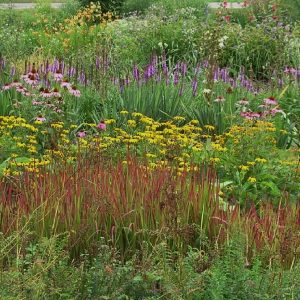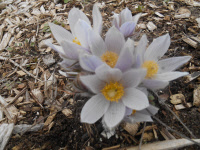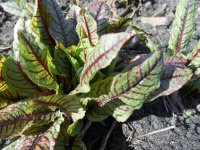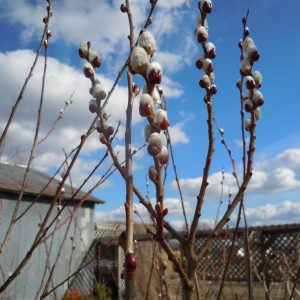Archives
Showing 121–128 of 164 results
-
Prairie Garden
Prairie Garden
OUT OF STOCK
Note: This is a plant not currently for sale. This is an archive page preserved for informational use.Prairie Garden Size : Height x width* Bloom color
3 Agastache foeniculum – Anise hyssop 2-3’ x 12” purple
3 Allium cernuum – Prairie onion 12”-18”x 3-6” pink
1 Aster cordifolius – Blue wood aster 2-3’ x 2-3’ blue
3 Bouteloua gracilis – Blue grama 2’ x 12” purple tinge
1 Desmanthus illinoensis – Prairie mimosa 4’ x 3’ white
1 Eryngium yuccifolium – Rattlesnake master 48” x 18” white
1 Eupatorium sessilifolium – Upland boneset 3-4’ x 12-24” white
1 Euphorbia corollata – Flowering spurge 36”x 18” white
3 Geum triflorum – Prairie smoke 12”x 8” pink
1 Hystrix patula – Bottlebrush grass 2-3’ x 12-18” purple/green
1 Monarda fistulosa – Beebalm 3-4’ x 2’ purple
1 Parthenium integrifolium – Wild quinine 2-3’x 12” white
1 Solidago riddellii – Riddell’s goldenrod 3’ x 2’ yellow
3 Sporobolis heterolepsis – Prairie dropseed 2’ x 2’ orange-copper
All plants are perennials.
If planted together in one garden these make a 32 square foot garden. *Most of these plants get wider over time by spreading roots or by self-seeding .
24 plants for $213.47. Would be $251.15 if purchased separately. You save $37.67.
If you plan on coming to the Nursery to purchase this collection, please give us at least 24 hours notice to prepare the collection for you. -
Primula vulgaris syn. Primula acaulis English primrose Z 4-8
Primrose yellow blossoms in earliest of spring.
ARCHIVED
Note: This is a plant not currently for sale. This is an archive page preserved for informational use.
Primrose yellow blossoms cheer on the earliest of spring.
Size: 6" x 6"
Care: shade in moist to moist well-drained soil. Immune to Walnut toxicity
Native: Europe
Awards: Received England’s Royal Horticultural Society Award of Merit.Primula is from Italian “primavera” meaning first spring. Vulgaris means common. Grown in the Eichstätt Garden, the garden of Johann Konrad von Gemmingen, prince bishop of Eichstätt in Bavaria, c. 1600. Grown by Jefferson. Grown at America’s 1st botanic garden, Elgin Botanic Garden 1811. Old medicinal uses to cure gout and headaches.
-
Pulsatilla patens syn. Anemone patens Eastern pasque flower Z 3-7
Up-facing blue-violet bells in early spring emerge from foliage decorated with silky hairs.
ARCHIVED
Note: This is a plant not currently for sale. This is an archive page preserved for informational use.
Up-facing blue-violet bells in early spring emerge from foliage decorated with silky hairs.
Size: 8-12” x 4-6" slow to grow, so be patient
Care: sun in moist well-drained to well-drained soil
Native: northern Great Plains including WI, Siberia, AlaskaThe name Pasque is Old French for Easter referring to the spring bloom time. Patens means “spreading.” South Dakota honors this as its state flower.
Collected for gardens prior to 1753. The Blackfoot made a decoction of this plant to speed a baby’s delivery and applied crushed leaves to skin to remedy irritation. Omaha applied fresh, crushed leaves as a poltice for rheumatism. -
Pulsatilla vulgaris var. ‘Alba’ Z 4-8
Pure white petals of open bell-shape with yellow centers flowers in early spring. Fun, furry foliage and Medusa-like seed heads.
ARCHIVED
Note: This is a plant not currently for sale. This is an archive page preserved for informational use.
Pure white petals of open bell-shape with yellow centers flowers in early spring. Fun, furry foliage and Medusa-like seed heads.
Size: 8-12” x 8-12”
Care: sun to part shade in well-drained to moist well-drained soil
Native: Europe
Wildlife Value: Deer resistant, early pollen source for bees
Awards: Royal Horticultural Society Award of Garden Merit“There is a variety of (Pulsatilla vulgaris) with white flowers…” Gardeners Dictionary, 1768.
-
Punica granatum var. nana Dwarf pomegranate Z 7-11
Adorable dwarf shrub bearing orange-red blooms in July and August then tiny, edible pomegranates. Where not hardy makes good container plant and bonsai.
ARCHIVED
Note: This is a plant not currently for sale. This is an archive page preserved for informational use.
Adorable dwarf shrub bearing orange-red blooms in July and August then tiny, edible pomegranates. Where not hardy makes good container plant and bonsai.
Size: 2-4’ x 2-4’
Care: sun to part shade in moist well-drained to well-drained soil
Native: Europe to Himalayas“The plants will bear miniature fruit if grown in areas with year-round temperatures that rarely fall below 40° F. To grow indoors, moderate night-time temperatures should be given (50° to 60° F). Keep at 40° to 45° F in winter until new growth appears. In the growing period, keep moderately moist. Water sparingly from August on. This plant requires good drainage. Plants will bear fruit indoors if grown in a sunny exposure.” Issour Botanic Garden. It is deciduous and may lose its leaves.
This dwarf described in 1803. -
Ranunculus acris ‘Flora-pleno’ Meadow buttercup Z 4-8 POISON
Scads of cheerful yellow balls made from many petals, bloom in early spring. Excellent cut flower
ARCHIVED
Note: This is a plant not currently for sale. This is an archive page preserved for informational use.
Scads of cheerful yellow balls made from many petals, bloom in early spring. Excellent cut flower
Size: 18-24” x 12” slowly spreading
Care: Sun to part sun in moist soil
Native: Europe
Wildlife Value: deer resistant, attract butterflies
Awards: Royal Horticultural Society Award of Garden MeritRanunculus is Latin for little frog, so named by Roman Pliny referring to the wet conditions required by some ranunculus. William Robinson considered this “pretty.” The English Flower Garden 1899.
-
Rumex sanguineus ssp. sanguineus Bloody dock Z 5-8
ornamental green foliage embroidered with red veins
ARCHIVED
Note: This is a plant not currently for sale. This is an archive page preserved for informational use.
Grown for its ornamental green foliage embroidered with red veins.
Size: 12" x 12"
Care: sun to shade in moist well-drained soil
Native: uncommon sport of species from Europe, SW Asia & N. Africa
Size: Containers, borders for bold effect. Young leaves of this Sorrel edible – taste like Chard. Adds color to salads & makes fine soup.Sanguineus means “blood-red”, from Latin sanguis, meaning “blood.” In gardens by 1760’s.
-
Salix discolor Pussy willow Z 4-8
Grown for its fuzzy catkins appearing in late winter before the leaves emerge
ARCHIVED
Note: This is a plant not currently for sale. This is an archive page preserved for informational use.
Grown for its fuzzy catkins appearing in late winter before the leaves emerge
Size: 15-20’ x 12-15’
Care: full sun, prefers moist soil but tolerates well-drained soil
Native: E. No. America incl. WI
Wildlife Value: Important food source for many pollinator bees incl. honey bees. Pussy willows attract queens looking for a location for a new colony. Host to caterpillars of cecropia moth and red-spotted purple, tiger swallowtail & viceroy butterflies.The name Salix is from “salio” meaning “to leap or dance, because of its quick growth.” Gardeners Dictionary, 1768. This species introduced to cultivation by German plant hunter Gotthilf Henry Ernest Muhlenberg in late 1700’s-early 1800’s. Willows contain salicin, the pain-killer in aspirin, and used since ancient Greece to relieve pain.





